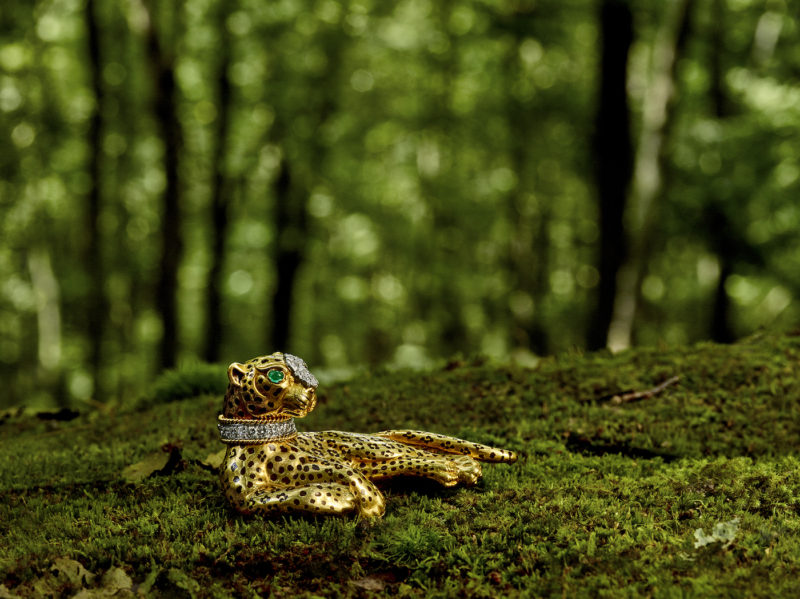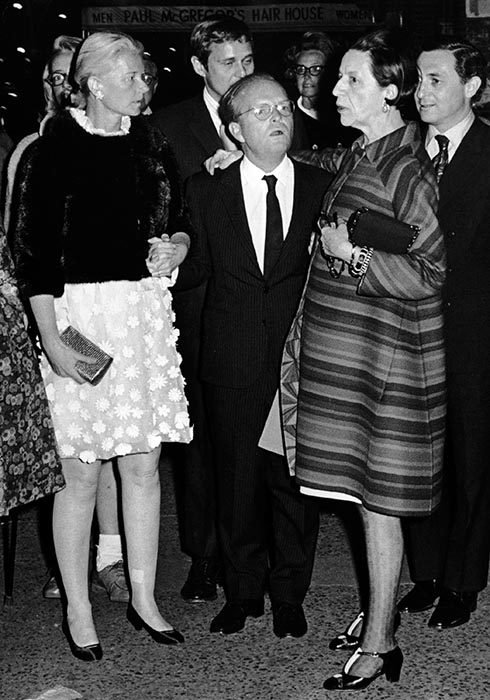
Bling
Animal Instinct
David Webb’s celebrated animal jewels, coveted by society swans and Hollywood divas in the 1960s, dazzle in a new jewelry exhibition.
Elizabeth Taylor. Diana Vreeland. The Duchess of Windsor. David Webb had a jeweler’s dream client list: a veritable who’s who of Hollywood stars and society swans who flocked to him for his bold, colorful designs, marked by a clever use of enamel and gemstones.
Born in Asheville, North Carolina in 1925, Webb brought an appreciation for nature with him when he moved to Manhattan and opened his eponymous company in 1948. A 1967 Vogue profile depicts him designing “in a great atrium under glass…surrounded by tropical foliage, animals of faïence, stone, vermeil, [and] his own brilliantly coloured paintings.” His bachelor pad had a zebra-skin rug.
The American jeweler created his first animal jewel—a double-headed makara cuff—in 1957. (Elizabeth Taylor would go on to buy this style in the 1960s). In 1964, Webb’s Kingdom Collection animal jewels were honored with the “Special Award for Jewelry Design” at the prestigious Coty American Fashion Critics’ Awards, the CFDA Fashion Awards of their day. (Geoffrey Beene took home the main fashion prize that year).
The award created a frenzy for Webb’s jewels. “Prizewinner starts a costly craze,” trumpeted a LIFE magazine story later that year that went on to proclaim how, “Barbaric and bizarre animals worked in hand-enameled 18-carat gold and set with precious stones have caused fashionable ladies to beat a path to the bejeweled jungle of David Webb in New York.”

Webb’s uniquely dignified animals did indeed attract a crush of society women, as demonstrated throughout the first-ever exhibition on now at the house’s Madison Avenue flagship. Titled A Walk in the Woods: David Webb’s Artful Animals, in homage to the avant-garde film Webb created to present his jewels at the Coty Awards, the exhibit offers an unprecedented opportunity to see his dazzling works in person, mixed with rarely seen archival photographs, drawings, and documents (it’s free, but requires a reservation).
While Webb was far from the first jeweler with an affinity for animals, what set his creations apart from Cartier panthers, Bulgari serpents, and Schlumberger birds, was, “a certain personality that isn’t too whimsical or fairy tale,” says Levi Higgs, the house’s Head of Archives & Brand Heritage. “His animals are stately without being too formal. It’s a very illustrative style.”


One of the first cases is dedicated to zebras, the house’s most popular and iconic animal. The striped design marked Webb’s first foray into what would become his signature enamel and gem-set animal bracelet series (the Metropolitan Museum of Art added a Zebra bracelet to its collection in 2018).
Accompanying the jewels are Irving Penn photographs from a 1964 issue of Vogue, where both the model’s eyeshadow and the black-and-white typography riff off the zebra ring she is wearing. Longtime Vogue editor Diana Vreeland, an admirer of Webb’s zebra jewels, was often seen wearing a cuff similar to the one on view, including to the premiere of Truman Capote’s Trilogy on May 6, 1968.
Elsewhere in the show is a receipt signed “Edward, Duke of Windsor” for a double-headed frog bracelet for his wife, Wallis Simpson. (Webb considered frogs “lucky”; the warts are 18-carat gold). The bracelet was apparently shipped to Palm Beach then sent back to New York for resizing ahead of the Duke and Duchess of Windsor’s steamship sailing for France on June 5, 1964.


In the snake display is a cobra bracelet similar to one in Gloria Vanderbilt’s collection. The artist, fashion designer, and socialite presented Webb with the Coty Award in 1964 and, shortly after, went on to purchase the snake design for herself. A family photograph hanging nearby, on loan from Vanderbilt’s son Anderson Cooper, shows Vanderbilt donning the bracelet.
The show also opens with the original film made by Webb for his Coty win, screened for the first time in more than half a century. While Coty Award winners traditionally participated in a runway show, Webb opted to commission illustrator Joe Eula and fashion photographer Milton Greene, known for his images of Marilyn Monroe, to make a short film featuring his creatures instead of modeling his jewels live. Called “A Walk in the Woods,” the film oscillates between shots of Webb’s jewels in nature and Eula’s sketches of the pieces.

The exhibit closes with a newly commissioned film by photographer and videographer Noah Kalina who created shot-by-shot references to the 1964 film, as well as moments inspired by it. “It was so bizarrely 1960s, done before Greene and Eula were working with Halston in the 1970s,” recalls Higgs of discovering the original film in the archives years ago. “I loved it and knew I wanted to make a new version.”
The current exhibit only scratches the surface of the house’s holdings. “We have so many things from the archive that make me ask, ‘What do we do with this? How do we get it out there?’” says Higgs. Those who follow him on Instagram regularly get inside looks. The rest of us will have to wait with bated breath to see what future marvels—and the glamorous figures who coveted them—will be unveiled uptown.
A Walk in the Woods: David Webb’s Artful Animals is on view at the jeweler’s Madison Avenue boutique through October 2nd. The exhibit is free, but reservations are required.



